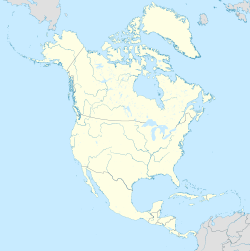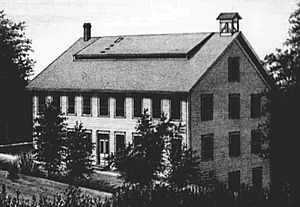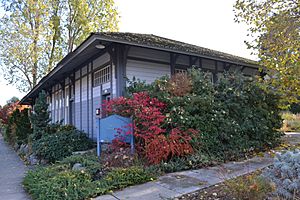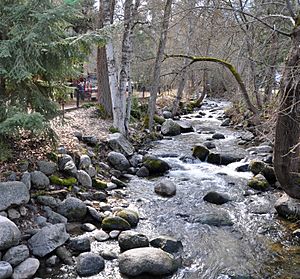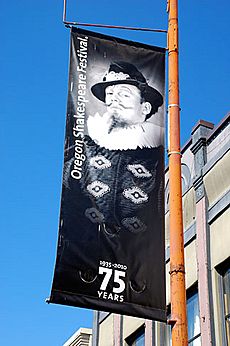Ashland, Oregon facts for kids
Quick facts for kids
Ashland, Oregon
|
|
|---|---|
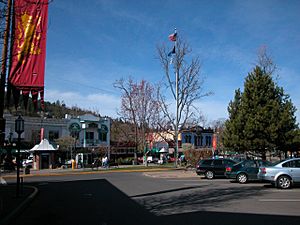
The Plaza
|
|
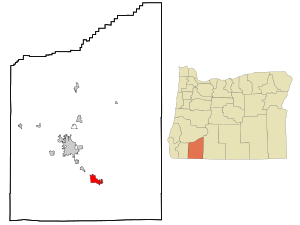
Location of Ashland in Jackson County and in the state of Oregon
|
|
| Country | United States |
| State | Oregon |
| County | Jackson |
| Settled | 1852 |
| Area | |
| • Total | 6.64 sq mi (17.19 km2) |
| • Land | 6.64 sq mi (17.19 km2) |
| • Water | 0.00 sq mi (0.00 km2) |
| Elevation | 1,949 ft (594 m) |
| Population
(2020)
|
|
| • Total | 21,360 |
| • Density | 3,218.81/sq mi (1,242.84/km2) |
| Time zone | UTC−8 (Pacific) |
| • Summer (DST) | UTC−7 (Pacific) |
| ZIP code |
97520
|
| Area codes | 541 and 458 |
| FIPS code | 41-03050 |
| GNIS feature ID | 1137318 |
Ashland is a city in Jackson County, Oregon, United States. It is located along Interstate 5, about 16 miles (26 km) north of the California border. The city is near the southern end of the Rogue Valley. In 2020, about 21,360 people lived in Ashland.
Ashland is home to Southern Oregon University (SOU) and the famous Oregon Shakespeare Festival (OSF). These two places are very important to Ashland's economy. Many restaurants, art galleries, and shops in the city serve the tourists who visit. Lithia Park, historic buildings, and a paved bike trail also attract many visitors.
The city was first called "Ashland Mills". It was named after Ashland County, Ohio, where its founder, Abel Helman, came from. It was also named after Ashland, Kentucky, because other founders had family there. Ashland has a city government run by a council and a city manager.
Contents
History of Ashland
Before White settlers arrived in the mid-1800s, the Shasta people lived in the valley where Ashland is now. In the 1820s, early hunters and trappers from the Hudson's Bay Company passed through the area. By the late 1840s, American settlers started using the Applegate Trail to travel through.
In the early 1850s, the Donation Land Claim Act brought many people to the Rogue Valley. This led to conflicts with the native people, known as the Rogue River Wars, which lasted until 1856.
In 1851, gold was found nearby, leading to the growth of Jacksonville. Settlers arrived in the Ashland area in January 1852. Abel D. Helman and others built a sawmill to make lumber. In 1854, they built a second mill, Ashland Flouring Mills, to grind wheat. The community around these mills became known as "Ashland Mills". A post office opened there in 1855.
During the 1860s and 1870s, Ashland Mills grew. It got a school, churches, and businesses. A big employer was Ashland Woolen Mills, which made clothes and blankets. In 1871, the Post Office dropped "Mills" from the name. In 1872, a college called Ashland Academy opened, which later became Southern Oregon University.
In 1887, Portland, Oregon, and San Francisco, California, were connected by train at Ashland. The city did well from train trade until 1926. After that, most trains used a different route to avoid the steep mountains.
In 1908, a women's club asked for a community park along Ashland Creek. This became Ashland Canyon Park. Around the same time, special lithia water was found. There was a plan to build a mineral spa at the park. Voters approved money for the project, which included piping the water to Ashland. John McLaren, who designed San Francisco's Golden Gate Park, helped design the park. It was renamed Lithia Springs Park, and later just Lithia Park. The spa plans were too expensive and were stopped in 1916.
In 1935, during a Fourth of July celebration, Angus L. Bowmer put on the first plays of what became the Oregon Shakespeare Festival. The festival has grown a lot and is now a famous theater company.
Many of Ashland's old buildings have been kept and fixed up. The city has 59 buildings and four areas listed on the National Register of Historic Places. These include the Enders Building, which was once the biggest store between Sacramento and Portland.
Geography
Ashland is about 1,949 feet (594 m) above sea level. It is in the foothills of the Siskiyou and Cascade mountains. The city is about 15 miles (24 km) north of the California border on Interstate 5. About 10 miles (16 km) south of Ashland is Siskiyou Summit, which is the highest point on I-5 at 4,310 feet (1,310 m). Ashland is also about 12 miles (19 km) southeast of Medford. The city covers about 6.6 square miles (17.1 km2) of land.
Ashland Creek starts in the Siskiyou Mountains south of the city. It flows through Ashland and joins Bear Creek. Bear Creek then flows northwest to meet the Rogue River. The Rogue River then flows west to the Pacific Ocean.
Oregon Route 99 goes through downtown Ashland. Oregon Route 66 also enters Ashland from the east. Route 66 goes east 63 miles (101 km) to Klamath Falls.
Climate
Ashland is in Oregon's southwest climate zone. This area is in the "rain shadow" of the Oregon Coast Range. This means it gets less rain than other parts of Oregon. While mountain peaks get a lot of rain, Ashland usually gets 20 inches (510 mm) or less each year. This valley climate is good for growing fruits like pears and other crops.
It rains in Ashland about 114 days a year. The average yearly snowfall is only about 1.4 inches (3.6 cm). Ashland has a warm-summer Mediterranean climate.
Ashland is usually a little cooler than Medford because it is 600 feet (180 m) higher up. December is the coolest month, with an average high of 47 °F (8 °C). July is the warmest month, with an average high of about 88 °F (31 °C). The hottest temperature ever in Ashland was 108 °F (42 °C) in August 1981. The coldest was −4 °F (−20 °C) in December 1972.
| Climate data for Ashland, Oregon (1991–2020 normals) | |||||||||||||
|---|---|---|---|---|---|---|---|---|---|---|---|---|---|
| Month | Jan | Feb | Mar | Apr | May | Jun | Jul | Aug | Sep | Oct | Nov | Dec | Year |
| Record high °F (°C) | 72 (22) |
78 (26) |
82 (28) |
94 (34) |
101 (38) |
105 (41) |
106 (41) |
108 (42) |
103 (39) |
97 (36) |
80 (27) |
70 (21) |
108 (42) |
| Mean maximum °F (°C) | 63 (17) |
68 (20) |
73 (23) |
81 (27) |
89 (32) |
94 (34) |
99 (37) |
99 (37) |
95 (35) |
84 (29) |
70 (21) |
62 (17) |
101 (38) |
| Mean daily maximum °F (°C) | 49.0 (9.4) |
53.7 (12.1) |
58.0 (14.4) |
62.8 (17.1) |
71.1 (21.7) |
78.5 (25.8) |
88.1 (31.2) |
87.4 (30.8) |
80.8 (27.1) |
68.0 (20.0) |
54.2 (12.3) |
47.2 (8.4) |
66.6 (19.2) |
| Daily mean °F (°C) | 39.3 (4.1) |
41.7 (5.4) |
44.9 (7.2) |
49.0 (9.4) |
56.1 (13.4) |
62.1 (16.7) |
69.4 (20.8) |
68.4 (20.2) |
62.0 (16.7) |
52.0 (11.1) |
43.3 (6.3) |
38.2 (3.4) |
52.2 (11.2) |
| Mean daily minimum °F (°C) | 29.6 (−1.3) |
29.7 (−1.3) |
31.8 (−0.1) |
35.2 (1.8) |
41.2 (5.1) |
45.8 (7.7) |
50.6 (10.3) |
49.4 (9.7) |
43.3 (6.3) |
36.1 (2.3) |
32.5 (0.3) |
29.2 (−1.6) |
37.9 (3.3) |
| Mean minimum °F (°C) | 19 (−7) |
21 (−6) |
23 (−5) |
26 (−3) |
31 (−1) |
37 (3) |
43 (6) |
42 (6) |
35 (2) |
26 (−3) |
21 (−6) |
17 (−8) |
14 (−10) |
| Record low °F (°C) | −1 (−18) |
−1 (−18) |
15 (−9) |
20 (−7) |
23 (−5) |
29 (−2) |
32 (0) |
34 (1) |
27 (−3) |
13 (−11) |
12 (−11) |
−4 (−20) |
−4 (−20) |
| Average precipitation inches (mm) | 2.35 (60) |
2.04 (52) |
2.03 (52) |
1.95 (50) |
1.64 (42) |
0.85 (22) |
0.44 (11) |
0.37 (9.4) |
0.50 (13) |
1.41 (36) |
2.57 (65) |
3.38 (86) |
19.53 (498.4) |
| Average snowfall inches (cm) | 0.5 (1.3) |
0.6 (1.5) |
0.2 (0.51) |
0 (0) |
0 (0) |
0 (0) |
0 (0) |
0 (0) |
0 (0) |
0 (0) |
0 (0) |
0.6 (1.5) |
1.9 (4.81) |
| Average precipitation days (≥ 0.01 in) | 14.1 | 11.9 | 13.4 | 12.7 | 9.6 | 5.3 | 2.5 | 2.6 | 3.9 | 7.5 | 15.2 | 15.0 | 113.7 |
| Source: NOAA | |||||||||||||
People in Ashland
| Historical population | |||
|---|---|---|---|
| Census | Pop. | %± | |
| 1860 | 327 | — | |
| 1870 | 400 | 22.3% | |
| 1880 | 842 | 110.5% | |
| 1890 | 1,784 | 111.9% | |
| 1900 | 2,634 | 47.6% | |
| 1910 | 5,020 | 90.6% | |
| 1920 | 4,283 | −14.7% | |
| 1930 | 4,544 | 6.1% | |
| 1940 | 4,744 | 4.4% | |
| 1950 | 7,739 | 63.1% | |
| 1960 | 9,119 | 17.8% | |
| 1970 | 12,342 | 35.3% | |
| 1980 | 14,943 | 21.1% | |
| 1990 | 16,234 | 8.6% | |
| 2000 | 19,522 | 20.3% | |
| 2010 | 20,078 | 2.8% | |
| 2020 | 21,360 | 6.4% | |
| Census sources | |||
In 2010, Ashland had 20,078 people living there. Most residents were White (about 90%). About 5% of the population was Hispanic or Latino.
The average age in the city was about 43 years old. About 16% of residents were under 18. Another 16% were between 18 and 24 years old. About 18% were 65 years or older. There were more females (54%) than males (46%) living in Ashland.
In 2010, the average income for a household was $41,334. By 2020, the population grew to 21,360. The average household income also increased to $64,000. In 2020, 96% of Ashland residents aged 25 and older had finished high school. Also, 62% had a college degree or higher.
Economy
Tourism brings a lot of money to Ashland. Many restaurants, art galleries, and shops serve the thousands of visitors. These visitors come each year to see plays at the Oregon Shakespeare Festival. In 2011, the festival sold over 390,000 tickets.
Southern Oregon University (SOU) is the city's biggest employer. It has more than 750 teachers and staff. Besides the Shakespeare Festival and the university, health services also help the economy. Businesses related to outdoor fun, transportation, technology, and small factories are also important.
Arts and Culture
The Oregon Shakespeare Festival started in the 1930s with summer outdoor plays. Now, its season runs from February to October. It features plays by Shakespeare and other writers in three theaters. It has become the largest regional theater company in the United States.
The Oregon Cabaret Theater shows musicals and comedies all year. It opened in 1986 in an old church building. The Ashland Independent Film Festival happens every April. It shows about 90 international and local films. In 2009, Ashland was the setting for the movie Coraline.
Southern Oregon University has the Oregon Center for the Arts. This center offers programs in art, music, and theater. It also has the Schneider Museum of Art, which shows modern art. The center hosts music concerts and other art events too.
The annual Ashland New Plays Festival (ANPF) helps playwrights create new plays. Each year, they choose four plays from many submissions. Professional actors read these plays to audiences during a five-day festival in October.
Museums and Other Fun Places
The National Fish and Wildlife Forensics Laboratory in Ashland is the only lab in the world that solves crimes against wildlife. Scientists there use forensic science to help investigate crimes against animals. They also help link victims to suspects for court cases.
The Ashland City Band (ACB) started in the late 1800s. The band plays public concerts each summer from June to August. They perform at the Butler Memorial Band Shell in Lithia Park.
Parks
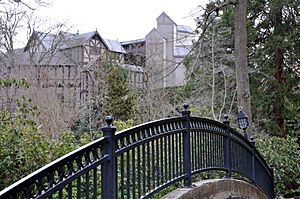
Lithia Park is a large park covering 93 acres (38 ha). It starts near the downtown shops and goes along Ashland Creek. The park has two ponds, a Japanese garden, tennis courts, and miles of hiking trails. The name Lithia comes from natural mineral water found in the area. This water has a strong mineral taste. Fountains with this water are in the town plaza.
The Bear Creek Greenway is a path for hiking and biking. It starts in Ashland near Ashland Creek. The 18-mile (29 km) path follows Bear Creek between Ashland and Central Point. It also goes through Talent, Phoenix, and Medford.
Calle Guanajuato is a small park next to Ashland Creek. It has several restaurants where you can eat outdoors.
Education
Southern Oregon University is a public university founded in 1926. It offers degrees in arts, science, business, and education. In Fall 2020, about 4,400 students attended the university. It also has programs for graduate students.
In 2020–21, about 59% of the students were women and 38% were men. The university had 19 students for every teacher. For Oregon residents, full-time undergraduate tuition was about $11,000 per year in 2020–21.
The Ashland School District manages three elementary schools. It also has alternative programs for younger children. There is one middle school and Ashland High School.
Media
The Mail Tribune, a newspaper from Medford, used to serve Ashland. It stopped printing in January 2023. The Mail Tribune also owned the Ashland Daily Tidings, which stopped printing in 2019. A new non-profit news group, Ashland.news, started in 2022.
Fifteen radio stations broadcast in the Ashland area. These include Jefferson Public Radio and KSKQ, a local non-profit station. Rogue Valley Community Television is based at Southern Oregon University. It serves Jackson and Josephine counties. Ashland does not have its own commercial TV stations, but Medford has seven.
City Services
The Asante Ashland Community Hospital is a general hospital. It is part of the Asante health network in Medford. In 2015, it had 49 beds for patients.
The Ashland Public Library building was made larger from the city's first Carnegie library. In 2003, the old part of the library was fixed up. In 2006, money problems caused the Ashland Library and 14 other libraries in Jackson County to close. This happened in April 2007 and lasted until October 2007. It was the biggest library closure in U.S. history.
Rogue Valley Transportation District (RVTD) provides bus service in Ashland. Buses connect to Medford, Central Point, Talent, Phoenix, and Jacksonville. In Medford, you can connect to other bus lines. The Klamath Falls Amtrak Station serves the Coast Starlight passenger train. Ashland Municipal Airport has a 3,600-foot (1,100 m) runway for small planes. Medford International Airport, 12 miles (19 km) from Ashland, also serves the city.
The City of Ashland worked to improve Internet access in the late 1990s. They created the Ashland Fiber Network (AFN) and built a fiber optic network. By 2006, the city had trouble paying for AFN. The city changed how AFN worked, focusing on high-speed Internet. In 2006, cable TV service was given to a local company, Ashland Home Net. The city kept the fiber network and the Internet business.
Sister Cities
Ashland has two sister cities:
 Guanajuato, Mexico
Guanajuato, Mexico Sviatohirsk, Ukraine
Sviatohirsk, Ukraine
Notable People
- Harry Anderson (1952–2018), magician and TV actor
- Angelique Ashby (1975−), born in Ashland, California State Senator
- Les AuCoin (1942–), former congressman
- Tai Babilonia (1959–), champion pairs figure skater
- John Backus (1924–2007), computer scientist who created Fortran
- Angus L. Bowmer (1904–1979), founder of the Oregon Shakespeare Festival
- Craig Chaquico (1954–), guitarist formerly with Jefferson Starship
- Gretchen Corbett (1947–), actress
- Chad Cota (1971–), former National Football League player
- Catherine E. Coulson (1943–2015), stage and screen actress
- Alex Cox (1954–), film director
- Ann Curry (1956–), former anchor on The Today Show
- Alice DiMicele (1965–), musician
- Jack Elam (1920–2003), actor
- David Fincher (1962–), film director
- Johnny Gruelle (1880–1938), creator of Raggedy Ann and Raggedy Andy
- Jeremy Guthrie (1979–), pitcher for the Kansas City Royals
- Johnny Harris, journalist and youtuber
- Anthony Heald (1944–), television, film, and stage actor
- Abel Helman (1824–1910), town founder
- Peter Hollens (1982–), independent a capella singer/songwriter
- Jean Houston (1937–), author and lecturer
- Lawson Fusao Inada (1938–), Oregon Poet Laureate 2006–10
- Dean Ing (1931–2020), author
- Hal Koerner (1976–), ultramarathon runner
- Winona LaDuke (1959–), Native American activist
- Leonard Levy (1923–2006), Pulitzer Prize-winning historian
- Rose Maddox (1925–1998), country-western musician
- Mark Parent (1961–), former baseball player
- Alfred Peet (1920–2007), founder of Peet's Coffee & Tea
- Jim Perry (1933–2015), television personality
- Bill Rauch (1962–), American theater director
- Tucker Reed (1989–), blogger, author, journalist and activist
- Jeff Rense, talk-radio host
- Ron Rezek (1946–), industrial designer and inventor
- Sonny Sixkiller (1951–), former National Football League quarterback
- Jon Micah Sumrall (1980–), lead singer of Christian rock band Kutless
- Jerry Turner (1927–2004), stage designer and director
- Neale Donald Walsch (1943–), author
- Henry Woronicz (1954–), actor and director
Images for kids
See Also
 In Spanish: Ashland (Oregón) para niños
In Spanish: Ashland (Oregón) para niños




